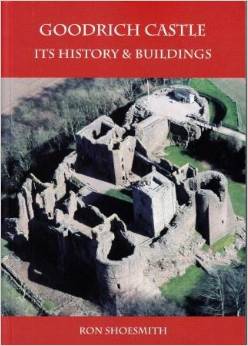Logaston Press:-
The most substantially complete medieval castle in Herefordshire, it is difficult to unpick how Goodrich Castle might have appeared due to the many buildings that have been replaced as it was adapted from a heavily defended castle to a comfortable house. Traces of the original hilltop defences have been all but obliterated by the subsequent rock-cut ditch and the stone buildings constructed within it – although parch marks indicating a double ditch are apparent near to the barbican. These could relate to an Iron Age hillfort, and/or the vallum monasterium of an early church, or even a simple castle ringwork. However, any early Norman timber buildings have long since gone. The first stone castle consisted of a simple small keep with a perimeter wall, built in the early 12th century. Mounding which was placed around the keep, which had a first-floor entry, was later swept away on three sides, the soil and perhaps material from the rock-cut ditch being spread over the courtyard, so raising the ground level. This was when the whole site was being converted into a grand Edwardian castle with round corner towers, a magnificent entrance, and two phases of a barbican that created almost a second castle outside the main entrance. New buildings including a chapel and great hall were erected within the courtyard. Later these, and other buildings, were joined together by a complicated arrangement of passageways and doorways, approached by several wooden staircases long since gone. Eventually the whole was transformed into a country house and manorial offices, only to be battered into partial ruin in the Civil War and left to moulder, though fortunately subject to minimal stone robbing.
The owners were initially Saxon then Norman, including major magnates of the realm. It was also home to a dowager countess whose household accounts survive to give a lively picture of the life of the castle when it was host to up to 150 people. Then there were the subsequent tenants who tried to keep the place in repair, only to see their efforts literally knocked to pieces. Afterwards came visitors in search of the Picturesque, followed by the Ministry of Works who stripped what had become a romantic ruin of its vegetation and repaired much of the stonework. It is now managed by English Heritage.








